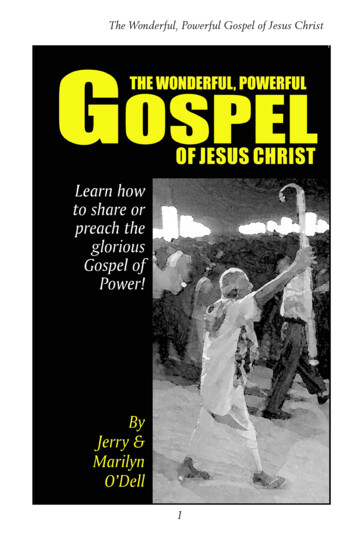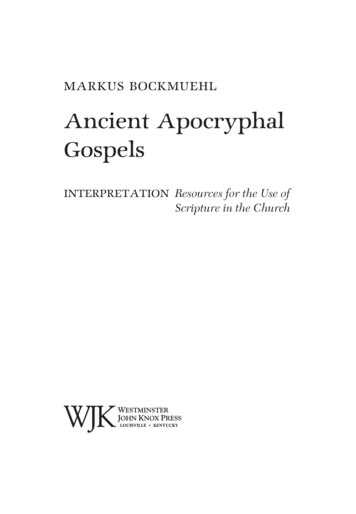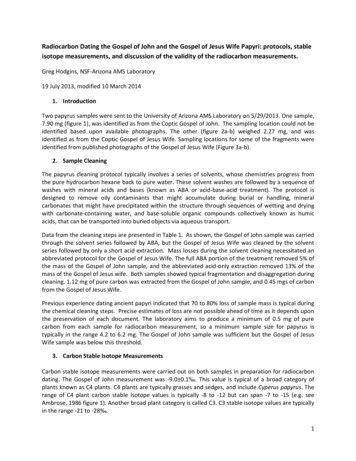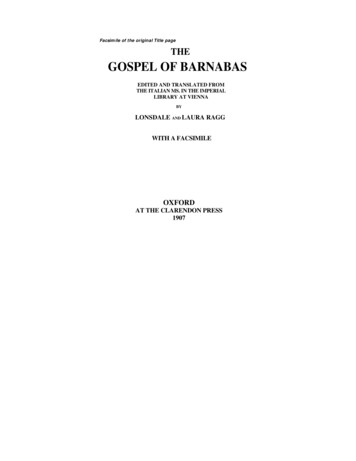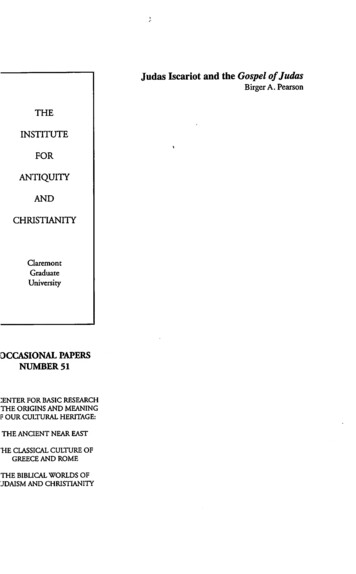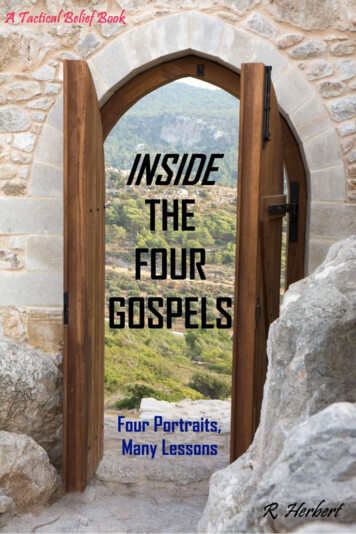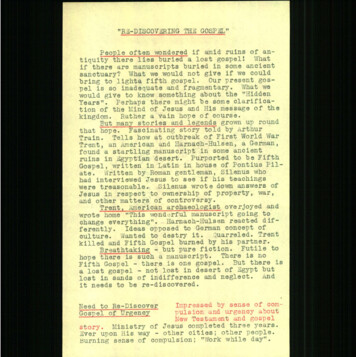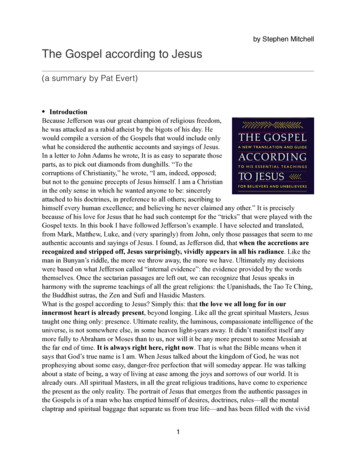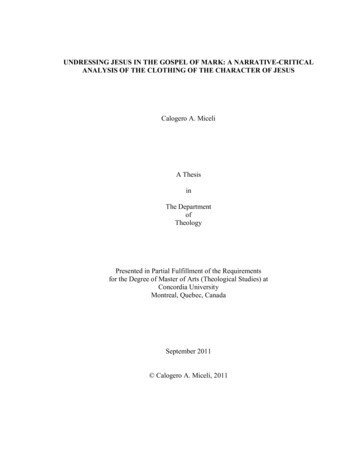
Transcription
UNDRESSING JESUS IN THE GOSPEL OF MARK: A NARRATIVE-CRITICALANALYSIS OF THE CLOTHING OF THE CHARACTER OF JESUSCalogero A. MiceliA ThesisinThe DepartmentofTheologyPresented in Partial Fulfillment of the Requirementsfor the Degree of Master of Arts (Theological Studies) atConcordia UniversityMontreal, Quebec, CanadaSeptember 2011 Calogero A. Miceli, 2011
CONCORDIA UNIVERSITYSchool of Graduate StudiesThis is to certify that the thesis preparedBy:Calogero A. MiceliEntitled:Undressing Jesus in the Gospel of Mark: A Narrative-Critical Analysis ofthe Clothing of the Character of Jesusand submitted in partial fulfillment of the requirements for the degree ofMaster of Arts (Theological Studies)complies with the regulations of the University and meets the accepted standards with respect tooriginality and quality.Signed by the final Examining Committee:ChairDr. Matthew AndersonExaminerDr. Marie-France DionExaminerDr. Jean-Michel RoessliSupervisorDr. André GagnéApproved byDr. Marie-France DionGraduate Program DirectorAugust 31, 2011Brian LewisDean of Facultyii
ABSTRACTUndressing Jesus in the Gospel of Mark:A Narrative-Critical Analysis of the Clothing of the Character of JesusCalogero A. MiceliThough combing through years worth of biblical commentaries, monographs, and journalarticles on Mark‘s gospel does reveal some valid insights and analyses by scholars onclothing in general, none of these has ever isolated all of the mentions of Jesus‘ clothingin Mark and elaborated this occurrence into a further and more in-depth study. Thefollowing thesis attempts to fill this void and engages the clothing of Jesus in Mark‘sgospel from a narrative-critical lens. The clothing which Jesus wears or does not wear ismentioned in several instances throughout, but these do not serve one singular purpose inMark‘s narrative. A common design or feature among all of the mentions is notimmediately clear nor does it seem likely that Mark intends a singular purpose for Jesus‘garments. Rather, the clothing of Jesus serves as different and unique literary devices ineach episode in which they are mentioned. Though there is no clear singular purpose forthe clothing of Jesus, in each case they are at work in symbolic, ironic, or foreshadowingways within the overall Markan narrative. The mention of Jesus‘ clothing at variousinstances makes it clear that these are important elements of the story and that they are anintegral part of the characterization of the protagonist.KEY WORDS: New Testament; Gospel of Mark; Jesus; Narrative Criticism; Literary;Synchronic; Symbolism; Clothing, Garments; Nudity; Robe; Purple Cloak; Crown ofThorns; Transfiguration; Haemorrhaging Woman; Linen Cloth; Young Maniii
ACKNOWLEDGEMENTSI would like to acknowledge the hard work and assistance of my thesis supervisorDr. André Gagné. Dr. Gagné has been a great mentor throughout these two years and hashelped to guide me into a field of study I am extremely passionate about.Many thanks also to the Department of Theological Studies at ConcordiaUniversity. The department and the people in it have been supportive of my research andhave been a tremendous part of my training in the field.Finally, I would also like to thank Tatiana for all of her help. Her hard work is aninspiration and a source of motivation for my own research even though they are worldsapart.iv
DEDICATIONI dedicate this thesis to the love of my life, Tatiana v
LIST OF ABBREVIATIONSABAnchor BibleATLAAmerican Theological Library Association Summary ofProceedingsBibBiblicaBibIntBiblical InterpretationBSacBibliotheca SacraCBQCatholic Biblical QuarterlyChrCentChristian CenturyChrLitChristianity and LiteratureCurTMCurrents in Theology and MissionFemTheFeminist TheologyHRHistory of ReligionsIntInterpretationJAARJournal of the American Academy of ReligionJAOSJournal of the American Oriental SocietyJBLJournal of Biblical LiteratureJETSJournal of the Evangelical Theological SocietyJSNTJournal for the Study of the New TestamentJSNTSupJournal for the Study of the New Testament: Supplement SeriesJSOTJournal for the Study of the Old TestamentJTSAJournal of Theology for Southern AfricaLDLectio DivinaMarkThe Gospel According to MarkNovTNovum TestamentumNTSNew Testament StudiesProofProoftexts: A Journal of Jewish Literary Historyvi
PRStPerspectives in Religious StudiesResQRestoration QuarterlySemeiaSemeiaScrNSScriptura: Nouvelle SérieTheofTheoforumThToTheology TodayTSTheological StudiesTynBulTyndale BulletinUSQRUnion Seminary Quarterly ReviewWITWWord in the World: Concordia University Graduate Journal ofTheological Studiesvii
LIST OF TABLESTable 1: Mark‘s ‗Sandwich‘ of the Hemorrhaging Woman Story .38Table 2: Mark‘s Narrative Sequence .41Table 3: Narrative Time (Original Chronological) . .43Table 4: Quinary Scheme of Mark 5:24-34 . . .48Table 5: The Progression of Jesus‘ Clothing in Mark 15:16-26 . .82Table 6: sindw,n in Mark‘s Gospel .98viii
TABLE OF CONTENTSIntroduction .1I Statement of the Question . 1II Status Quaestionis . .8II.i Study of Clothing in Mark‘s Gospel . 9III Epistemology & Methodology .14III.i Epistemology .14III.i.i Ethical Considerations .15III.ii Methodology 17III.ii.i Translation & Textual Criticism .17III.ii.ii Narrative Criticism . 18III.ii.ii.i Brief History of Narrative Criticismand Mark‘s Gospel .19III.ii.ii.ii Advantages of Narrative-Criticism . 20III.ii.ii.iii Limits of Narrative-Criticism .22III.iii Diachronic Considerations 27Chapter One:‗If I But Touch His Clothes, I will be Healed‘:The Healing Power of Jesus‘ Clothes (Mark5:21-34; 6:53-56) . .291.1 Introduction .291.2 Greek Text & English Translation .301.3 Literature Review .311.3.1 Historical Understanding of Jesus‘ Clothing .321.3.2 Faith and Will as Healing Agents 341.3.3 Mark‘s Sandwich Technique .371.4 Narrative Analysis .391.4.1 Place .401.4.2 Narrative Time . 411.4.3 Plot . .471.4.4 Symbolism of Clothing . .50ix
1.4.5 Healing of the Sick on Mats . 521.5 Conclusion . 53Chapter Two:―His Clothes Became Shinning White‖: TheProleptic White Clothes of Jesus (Mark 9:2-8;[16:1-8]) . .552.1 Introduction . 552.2 Greek Text & English Translation . .562.3 Literature Review .572.3.1 Historical Understanding of Jesus‘ Clothing .582.3.2 Intertextuality .592.3.3 Symbolism of White Clothes .612.4 Narrative Analysis .632.4.1 Young Man & Jesus .642.4.2 Prolepsis / Depiction of the Resurrected Jesus . .652.4.3 Symbolic of Immortality . 682.5 Conclusion .69Chapter Three:‗Hail, King of the Jews!‘: Irony and Symbolismat Jesus‘ Death (Mark 15:16-26) . .703.1 Introduction . .703.2 Greek Text & English Translation . .713.3 Literature Review . 713.3.1 Historical Understanding of Jesus‘ Clothing . 723.3.1.1 Purple Garment and Thorn Covered Crown (15:16-20) .733.3.1.2 Casting Lots on Jesus‘ Clothes (15:21-26) . 743.3.2 Intertextual Parallels . .753.3.3 Symbolic and Ironic Understanding 773.4 Narrative Analysis . 803.4.1 Purple Garment and Thorn Covered Crown . .813.4.2 Emblematic of Jesus‘ Kingly Status 833.4.3 Hero and Villains .843.4.4 Dividing of Jesus‘ Clothes and Tearingx
of the Temple Curtain . 863.5 Conclusion . 87Chapter Four:‗He Wrapped Him in The Linen Cloth‘: TheNarrative Function of Jesus‘ Burial Garment(Mark 15:46; [14:51-52]) .894.1 Introduction . 894.2 Greek Text & English Translation .894.3 Literature Review .904.3.1 Linen Cloth Ignored .904.3.2 Linen Cloth and the Young Man . 914.4 Narrative Analysis . .934.4.1 Rethinking Hester‘s Narrative Understanding of the Cloth .944.4.1.1 Diverging with the Dissociation of the Disciples .944.4.1.2 Diverging with the Tragedy of the Event 964.4.1.3 Connecting Once More the Young Man with Jesus 974.4.2 Foreshadowing Jesus‘ Escape from the Linen Cloth .984.5 Conclusion . 99Conclusion .100Appendix A: Table of Mentions of Clothing in Mark‘s Gospel .105Bibliography . .109Consulted Works .114xi
‘Une découverte étonnante attend celui qui fixe ses yeux sur le vêtement dans l’ÉcritureSainte.’Edgar Haulotte (1966)‘Hence clothes in the Gospel of Mark generally bear emblematic connotations.’Mary Ann Tolbert (1989)‘Clothing seems like an incidental item, of little relevance to narrative analysis. Yet itmay symbolize new stages in a character’s development, or reveal the inner landscape ofa character–his or her values and commitments–or it may accent a character’s socialand spiritual status.’James L. Resseguie (2005)INTRODUCTIONI Statement of the QuestionWhile reading or listening to a story, it is easy for anyone to be distracted by thenarrative to the point where small details are overlooked and disregarded. When thinkingabout the canonical gospels, many have a difficult time telling the books apart orrecalling from which of the gospels certain episodes of Jesus belong. This is not at alluncommon. It is the reason why stories are retold, reread, and rewritten.When thinking of Jesus and particularly the Gospel according to Mark, many aresurprised to hear that the clothing of Jesus is a part of the narrative or that Markreferences Jesus‘ clothing in his story. What Jesus wears over his body is a detail ofMark‘s gospel which many readers, both past and present, tend to overlook in theirreading of the text. In Mark‘s gospel, however, clothing is a crucial part of the narrativeas it is mentioned in nineteen different episodes.1 Of these nineteen episodes, about onethird (that is six) refer specifically to the clothing of the protagonist Jesus. The firstreference to Jesus‘ clothing is recorded in the story where Jesus heals a woman who has1These episodes are the following: Mark 1:6, 10; 2:21; 5:14-7, 21-34; 6:8-9, 55-6; 9:2-8; 10:50; 11:7-8;12:38; 13:16; 14:51-2, 63; 15:16-20, 21-6, 38, 46; 16:1-8.1
been haemorrhaging for twelve years (5:25-34).2 In this story, Jesus‘ clothes play aprominent role as they are the catalyst for the woman‘s healing after she touches themwithout Jesus‘ consent. The clothing of Jesus as a means for healing is also featuredduring Jesus‘ ministry when he heals the sick in Gennesaret (6:53-56). In this succinctepisode, many beg Jesus to touch the fringe of his garment and are healed as a result ofthis action. In the transfiguration episode, Jesus brings three of his disciples with himatop the mountain away from the other followers (9:2-8). It is in this scene that Jesus‘clothes are transformed to shinning white which is described as being so white, that nobleacher on earth could have been able to reproduce such brilliance. Later on – andperhaps most memorable of all of the clothing passages – are the mentions of clothingwhich take place during the passion narrative of Jesus. Here, the clothing of Jesus is amajor part of Mark‘s passion narrative as the Roman soldiers are said to have dressedhim in a purple garment, and they placed on his head a crown of thorns (15:17). Afterflogging and mocking him, the soldiers proceed to strip Jesus of the cloak (15:20a) andput his own clothes back on him (15:20b). At the crucifixion of Jesus not long after, thesoldiers are described as having cast lots in order to divide amongst themselves theclothing of Jesus (15:24). Finally, after the death of Jesus, Joseph of Arimathea enters thestory and wraps the body in linen cloth for burial (15:42-47). The references to theclothing of Jesus are prominent throughout the gospel, but they are mentioned most oftenduring the passion and death of the main character. In all of these instances, the storyturns its attention to the special detail of attire and gives the audience what can bedescribed as the only physical details recorded in the canonical gospels concerning theappearance of Jesus of Nazareth.2All scriptural references refer to the Gospel according to Mark unless otherwise noted.2
With all of these references to clothing, one might ask: Why does Mark take thetime to mention the clothing of Jesus? And to go even further: What is the purpose or therole of the garments of Jesus within the Markan narrative? Is there a reason or reasons formentioning such specific physical details of the story or are these references to Jesus‘clothing simply additional information with no intended purpose?Surely for some readers of these texts, the mentions of the clothing of Jesus yieldlittle interest or concern, and such supplemental details may be conjectured of aspointless information within the Markan narrative. The Gospel according to Mark isfilled with details not all of which are easily explained or which seem immediatelyimportant to the story as a whole. Of course, I would contend that even if something isnot easily discernable, that does not make it insignificant or any less relevant. In fact, Iwould strongly argue that Mark‘s narrative is one which demands of its audience acareful rereading (or careful retelling) not just because of an incomplete ending3 whichforces a reader back to its beginning, but because of the nature of Jesus‘ secretive andencrypted message. As far as the clothing of Jesus goes, I argue that the fact that these arementioned six times throughout the gospel reveals that they are an important factor of thestory, and all of these mentions create for the text a literary motif. All of the references toJesus‘ clothing in Mark are of importance and throughout the narrative they are utilizedas a wide range of literary devices. Mark does not mention the clothing of Jesus as apassing remark or as filler like some might come to assume; rather, the fact that Jesus‘garments are mentioned so many times is a clear indication of their relevance and theirfunctionality within the Markan story.3If we assume, as most scholars do, that Mark‘s gospel originally ended inconclusively at 16:8.3
Throughout this thesis, I explore the particular aforementioned aspect of theGospel according to Mark which has hitherto received little scholarly attention. Thoughcombing through years worth of biblical commentaries, monographs, and journal articleson Mark‘s gospel does reveal some valid insights and analyses by scholars on clothing ingeneral, none of these has ever isolated all of the mentions in Mark and elaborated thisoccurrence into a further and more in-depth study. For the most part, scholars havegenerally commented on the various mentions of Jesus‘ clothing, but often in isolationfrom the other occurrences. The references to the clothing of Jesus, as shown above, arenumerous and these are now explored within the Markan narrative as a whole (though notnecessarily as having one function which they all share as I discuss later on). Until now,no one has stepped back, examined the bigger picture regarding the clothing of Jesus, andasked the question I am asking which is: Why does Mark mention the clothing of Jesus?4With the use of narrative-critical tools, the thesis engages this question and others inorder to make sense of the mentions of the clothing of Jesus in Mark‘s text. The overallaim is to enhance our understanding of Mark’s gospel and argue convincingly that thereferences to Jesus’ clothing are not insignificant details which were included byhappenstance. This thesis examines each mention of clothing for Jesus in Mark’s gospeland argues that they work as symbolism, foreshadowing, irony, and as other literarydevices. The fact that Mark speaks of clothing so often in the gospel indicates theimportance of this feature within the overall story.Each chapter is a detailed study and analysis of one or more particular mentionsof Jesus‘ clothing. At the beginning of each chapter, I have provided the most current4Though in this brief article the question only concerns the clothing removed by Bartimaeus; Alan R.Culpepper, ―Mark 10:50: Why Mention the Garment?‖ JBL 101 (1982): 131-2.4
critical edition of Greek passages5 of the pericope in question followed by my ownEnglish translation of the text. Immediately following each translation the chapter brieflyintroduces and surveys previous scholarship pertaining to the passages and follows-upwith a narrative-critical analysis of the clothing of Jesus.The first chapter of the thesis explores the clothing of Jesus whereby his garmentshave the ability to heal the ailments of any who touch them. In Mark 5:25-34, a womantouches the clothing of Jesus and is miraculously healed. In Mark 6:53-56, Jesus arrivesto the land of Gennesaret where people – recognizing him – bring the sick to the agoraein order to touch his garments and be healed as a result of this contact. The first twomentions of Jesus‘ clothing reveal a similar event whereby particular characters, inrecognizing who Jesus is, touch his garments in the hopes of being cured. What isfascinating about these stories is that Jesus himself is not responsible for the healing as isthe case in the other miracle stories;6 rather, it is the clothing of Jesus which is able tocure independently from the knowledge (perhaps even willingness) of Jesus. These firstpassages reveal a key component of Mark‘s narrative, namely that the clothing of Jesus isa pivotal part of it. Jesus‘ clothes here are not mentioned as visual aids, but as literarydevices which bring attention to the garments of the protagonist and help to characterizeJesus. These first references to clothing are a clue for the audience that Jesus‘ attire is andwill continue to be a vital part of the narrative because they – in their ability to heal – areas powerful as the main character and his twelve disciples (6:6b-13).7 The mentions of5The Greek passages have been taken from Nestle-Aland, Novum Testamentum Graece: Standard Edition.Twenty-Seventh ed. Hendrickson Press, 2010.6Mark 1:40-45; 2:1-12; 5:35-43; 7:31-37; 10:46-52; in all of these instances Jesus uses his touch and wordsin order to heal. No mention is made of his garment and Jesus is the one who initiates the healing.7In this episode, the disciples are given power to exercise unclean spirits and to anoint and cure the sickpeople they encounter. The clothing of Jesus also has the rare ability to cure.5
clothing in these two episodes set up the rest of the narrative whereby it is made clear thathis garments have an important role in the story, which will be seen in what is to comelater on in Jesus‘ ministry and death.In the second chapter, the transfiguration of Jesus episode is examined for itsunique display of Jesus‘ clothing (9:2-8). In this episode, Jesus‘ clothes become shinningwhite as he is transfigured before three of his disciples atop a mountain. The episode isunique in its portrayal of Jesus, but also in its allusions to Hebrew Bible texts andcharacters. In this scene, the attire of Jesus works as a narrative device in several differentbut unifying ways. The white clothing of Jesus acts as a literary device in that itsymbolically reveals for the audience Jesus‘ immortality since his clothes are connectedto the scene at the empty tomb. As such, the clothing of the protagonist successfullyforeshadows what will transpire at the end of the gospel. The clue provided by the whiteclothes for the reader as to what is yet to come will be realized during the closing stagesof the story when the women enter the empty tomb of Jesus and find a young man sittingthere dressed in white (16:1-8). Thus, the white that Jesus wears at the transfigurationscene echoes the end of the gospel and connects Jesus with the young man whilesimultaneously connecting the Jesus dressed in white clothes with the unseen resurrectedJesus. In reading about the young man and the white robe, a reader is reminded of thetransfiguration of Jesus episode where he is speaking with prophets of the past in thepresence of God atop the mountain. By means of these connections, the transfigurationepisode can be viewed in conjunction with the resurrection account.The third chapter of the thesis investigates the mocking of Jesus by the Romansoldiers (15:17-18) as well as their casting lots for Jesus‘ clothes (15:24) and how the6
clothing here works as irony and symbolism. At the time of his crucifixion, the soldiersmock Jesus by dressing him in a purple garment and placing on his head a thorn coveredcrown. After being ridiculed by the Romans who had dressed him in a purple outfit, thesoldiers take back the garment and dress Jesus in his own attire (15:20). They then leadhim to be crucified and divide his garments amongst themselves (15:24). The ironicaspect of the aforementioned scene is unmistakable and reaches its peak when thesoldiers bow to him and say aloud, ―Hail, King of the Jews!‖ In this episode, the clothingthat Jesus wears is ironic in that he has actually become the king and the intendedaudience is well aware of such a missed attempt of ridicule on the part of the soldiers.Jesus also foretells the coming of the kingdom of God within the gospel and the clothinghere symbolically emphasizes his prophetic words. Therefore, Jesus‘ garments reveal anironic scenario whereby Jesus – being dressed in kingly clothes – will succeed inestablishing the kingdom of God and the clothes also work as latent symbolic imagerywhich reveals Jesus‘ kingly position.The fourth and final chapter follows the last mention of Jesus‘ clothing. After thecrucifixion account, Joseph of Arimathea wraps the naked body of Jesus in linen clothand buries him (15:46). This enigmatic mention of clothing once more furthers theconnection between the protagonist and the young man. When the audience learns thatJesus has been buried in a linen garment they can reflect upon the outset of Jesus‘ death,namely the time of his arrest and how the youth was stripped of his own linen cloth. Theundressing of the young man‘s linen garment (14:51-2) foreshadows Jesus‘ escape fromthe linen burial cloth at the end of the gospel when his prophecy is fulfilled and he is7
resurrected. The narrative function of the linen garment, which was originally proposedby David Hester, is presented, critiqued, and expanded upon throughout this chapter.Finally, the thesis concludes by revisiting the overall motif of Jesus‘ clothing inMark‘s gospel and suggests avenues for further research on this topic. The clothing ofJesus is a crucial part of the Markan narrative, but there are many other mentions ofclothing in Mark‘s gospel which are in need of closer literary analyses. Even beyondMark‘s borders, the mentions of Jesus‘ vestment and of clothing in general are recurrentthroughout much canonical and non-canonical biblical literature. This theme, which isimportant and lacking in scholarly attention, should continue to be studied and analyzedin the hopes of achieving a better understanding of the text at hand and of the differentliterary elements embedded within the narratives.II Status QuaestionisIn the case of Mark‘s gospel, the voices are plenty and the bookshelves areoverstocked with various publications which have come about over the course of twothousand years. As a scholar who wishes to examine Mark‘s gospel today, it is importantand necessary to be able to make sense of the past and how we have come to where weare now in terms of our understanding of the second canonical gospel. This researchinvolves a close examination of the scholarly literature on Mark and an understanding ofthe current ideas which Markan scholars have proposed.8
II.i Study of Clothing in Mark‘s GospelSince Mark‘s gospel has been around for the better part of two millennia, there isno wonder why a search for scholarly material on the subject yields overwhelmingresults. Over the many years there have been countless commentaries and commentatorswho have partaken in the dialogue by observing and analyzing the clothing of Jesus in theGospel according to Mark. Here, I offer a brief overview of what scholars have writtenover the years, specifically concerning the mentions of the clothing of Jesus. Thisoverview of literature concerning the Jesus clothing passages in Mark is meant to putforward an idea of the history of this scholarship in broad strokes. Specific thoughts andideas particular to each individual pericope are later revisited in greater detail andspecificity within the introduction of each chapter of this thesis.In the early 20th century, when commenting on the Jesus clothing passages, amajority of authors were concerned primarily with the historically practical uses of Jesus‘clothing. That is to say that for most scholars, the clothing of Jesus was relevantinsomuch as it could be understood from a realistic perspective (What did Jesus wear?What materials or colors were the clothes of Jesus made up of?). Concerning thehaemorrhaging woman who touches Jesus‘ clothing (5:25-34), for example,commentators would note the requirements of Jewish law and elaborate on the colors andmaterials that likely would have been used for Jesus‘ garments, basing that informationon the books of Numbers and Deuteronomy. No doubt such conceptions about the exactclothing Jesus wore are fuelled by readings of the same event in other gospels. 8 Such8Mann points out that, “Matthew‘s version refers to the tassels attached to the corners of the cloak (cf.Num 15:38, Deut 22:12),‖ (Christopher S. Mann, Mark: A New Translation with Introduction andCommentary. [Garden City, N.Y.: Doubleday, 1986], 285).9
concerns about the historically-centered details of the clothing that Jesus wore9 begin totransform as the years go by, and while they remain the main focus of commentaries upuntil the late 1970‘s, these begin to loose track and are overtaken by evolving concerns.During the late 1970‘s and early 1980‘s different conceptions about Jesus‘ clothing in thepassages of Mark‘s gospel begin to take shape.Historical concerns soon give way to more symbolic and allegorical readings asthese become the main focus of Jesus‘ clothing in Mark up until the present day. Nodoubt, the same trend in progression of scholarly research from historical tonarratological is mirrored in the shift of methodologies utilized by New Testamentscholars who began to implement narrative readings of the canonical gospels during thesame period (i.e. late 1970‘s and early 1980‘s). These more recent narratological readingshave been concerned with examining the literary aspects and characteristics of Jesus‘clothing; though these are most often done in isolation from one passage to another. Saiddifferently, the clothing passages are almost always examined as single units within Markand not as a whole or as a motif throughout the gospel. Most notable of such allegoricaland ironic readings stems from the passage in which the Roman soldiers mock Jesus,dress him in a purple robe, and place a thorn covered crown over his head (15:17-18).Many scholars, having examined this particular scene, have applied a narrative reading of9For other historical concerns with the clothing of Jesus see: Hugh Anderson, The Gospel of Mark.(London: Oliphants, 1976), 339; C. E. B. Cranfield, The Gospel According to Saint Mark: An Introductionand Commentary (London: Cambridge University Press, 1972), 230, 453, 455; Sherman E. Johnson, ACommentary on the Gospel According to St. Mark. (London: A. & C. Black, 1960), 128; Alexander Jones,The Gospel According to St. Mark; A Text and Commentary for Students (New York: Sheed & Ward,1963), 119, 235. William L. Lane, The Gospel According to Mark: The English Text with Introduction,Exposition, and Notes (Grand Rapids: Eerdmans, 1974), 559-60; Dennis E. Nineham, The Gospel of St.Mark. (Harmondsworth: Penguin, 1969), 186, 420; Eduard Schweizer, The Good News According to Mark.(trans. D.H. Madvig: Richmond: John Knox Press, 1970), 341; Vincent Taylor, The Gospel According toSt. Mark: The Greek Text with Introduction, Notes and Indexes (2d ed.; New York: St. Martin's Publishing,1966), 589.10
the text in order to better understand this episode. Concerning the allegory of the Romansoldiers‘ actions, Tannehill writes:The irony here actually has two levels. The soldiers act and speak ironically,outwardly they proclaim Jesus King of the Jews but actually they are rejecting hiskingship. However, the reader is meant to take the soldiers‘ irony ironically, i.e.,as pointing to a hidden truth. This reading is supported by the repeated referencesto Jesus as Christ and king in the passion story.10The ironic conception of the passage is echoed in later studies of this section in Mark aswell.11 But while more narrative based understandings slowly start to emerge in thescholarly literature, still today there is lacking an overall – taking into account the entiregospel – understanding of Jesus‘ clothing in Mark. From the vast array of academicarticles, commen
Undressing Jesus in the Gospel of Mark: A Narrative-Critical Analysis of the Clothing of the Character of Jesus Calogero A. Miceli Though combing through years worth of biblical commentaries, monographs, and journal articles on Mark‘s gospel do

